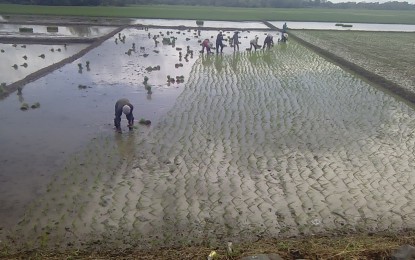
SCIENCE CITY OF MUNOZ, Nueva Ecija -- The Philippine Rice Research Institute (PhilRice) has recommended the use of drought-tolerant varieties and technologies to help farmers cope with the ongoing El Niño phenomenon.
PhilRice agriculturist Fredierick Saludez said rice farmers must be prepared to plant drought-resistant varieties that could help them mitigate the impact of prolonged dry spell.
Based on studies, rice normally grows at temperatures between 20-35 degrees Celsius. Temperature above 35 degree Celsius is critical for rice growth especially during the reproductive stage.
Likewise, rice yield can decrease by 10 percent for each 1degree Celsius increase in minimum night temperature during the dry season.
Aside from planting drought-tolerant rice varieties, Saludez said farmers with water source can also try the aerobic rice technology which requires irrigation at 2-5 centimeter every week.
He said farmers in irrigated areas, meanwhile, are advised to use water efficiently so it can reach tail-end areas in the irrigation system.
By practicing controlled irrigation, he said water use can be reduced by around 16-35 percent without reducing yield.
“This technology is aided with an observation well used in monitoring water levels. It is time to irrigate when the water level hits 15 centimeter below ground level,” Saludez said.
While PhilRice recommends a fallow period every cropping season, in times of drought, it also encourages farmers with stable water supply to plant rice immediately after harvest.
Dr. Eduardo Jimmy P. Quilang of PhilRice Agronomy, Soils, and Plant Physiology Division, said the practice, called “quick turnaround (QTA),” has to be done in synchrony within a community.
“QTA is advised to ensure enough rice supply amid the dry spell. In doing this, however, synchronous planting is strongly recommended to prevent pest outbreak. Thus, this has to be well-coordinated with the National Irrigation Administration,” he said.
Likewise, PhilRice recommended to farmers application of direct seeding to reduce production time by an average of 10 days.
In areas with limited water supply, Dr. Ricardo Orge, program leader of Climate Resiliency for Enhanced Agricultural Trade and Efficiency for Rice (CREATE-Rice) Program, advised farmers to diversify from rice.
“If it is already too risky to plant rice, farmers may consider planting short-duration crops instead. We suggest high-value crops requiring less water use such as watermelon. Farmers may also focus on tending livestock,” Orge said.
The PhilRice experts also encouraged farmers to avail of farm insurance to protect their crops from natural calamities. (PNA)
